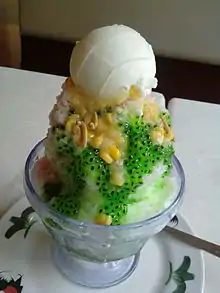Ais kacang
Ais kacang (Malay pronunciation: [aɪs ˈkatʃaŋ]), literally meaning "bean ice", also commonly known as ABC (acronym for Air Batu Campur [air ˈbatu tʃamˈpʊr], meaning "mixed ice"), is a Malaysian dessert which is also common in Singapore (where it is called ice kachang) and Brunei.[1][4]
 | |
| Course | Dessert |
|---|---|
| Place of origin | Malaysia |
| Region or state | Southeast Asia |
| Associated national cuisine | Malaysia, Singapore, Brunei |
| Created by | Malaysian Malay[2] |
| Main ingredients | Shaved ice, red beans[3] |
Traditionally, an ice shaving machine is used to churn out the shaved ice used in the dessert, originally hand cranked but now more often motorised. Many Southeast Asian coffee shops, hawker centres and food courts sell this dessert. Ais kacang is considered one of Malaysia's most unique dishes, and is featured[5] in many articles as such.
Preparation
Ice kacang was originally made of only shaved ice and red beans,[3] though the number and diversity of ingredients has since expanded.[6] Today, ais kacang generally comes in bright colours, and with different fruit cocktails and dressings.
In Malaysia, almost all variants now contain a large serving of attap chee (palm seed), red beans, sweet corn, grass jelly, roasted peanuts and cubes of agar agar as common ingredients. Other less-common ingredients include aloe vera, cendol, nata de coco, or ice cream. A final topping of evaporated milk, condensed milk, or coconut milk is drizzled over the mountain of ice along with red rose syrup and sarsi syrup.[7] Some stalls have even introduced novelty toppings such as durian,[8] and chocolate syrup. There are also versions that shun the multi-coloured syrup and are served with just a drizzling of palm sugar syrup instead.
See also
- Es campur – a similar dessert from Indonesia
- Es teler – a similar dessert from Indonesia
- Es cendol – a similar dessert from Indonesia
- Granita – a similar dessert from Italy
- Halo-halo – a similar dessert from Philippines
- Tsuaping – a similar dessert from Taiwan
- Kakigōri – a similar dessert from Japan
- Namkhaeng sai - a similar dessert from Thailand
- Bingsoo – a similar dessert from Korea
- Red bean ice – a similar dessert from Hong Kong
- Snow shaved ice – a similar dessert from United States
- Gola – a similar dessert from India
- Falooda – a similar dessert from Iran
- Baobing – a similar dessert from China
References
- Sidney Mintz (2015). The Oxford Companion to Sugar and Sweets. Oxford University Press. pp. 637–. ISBN 978-0-19-931339-6.
- Chris Rowthorn; Muhammad Cohen; China Williams (2008). Borneo. Ediz. Inglese. Lonely Planet. pp. 329–. ISBN 978-1-74059-105-8.
• Mat Oakley; Joshua Samuel Brown (2009). Singapore. Ediz. Inglese. Lonely Planet. pp. 204–. ISBN 978-1-74104-664-9.
• Georgeta Raţă (3 January 2013). The English of Tourism. Cambridge Scholars Publishing. pp. 168–. ISBN 978-1-4438-4486-4. - Mat Oakley (2008). Singapore. Con cartina. Lonely Planet. pp. 60–. ISBN 978-1-74104-884-1.
- Yeoh, En-lai (9 March 2012). "Down by the Boardwalk in Singapore". The Wall Street Journal. Retrieved 13 March 2012.
- "You Don't Know Malaysia Until You Try These 25 Street Foods". Traveler Door. 25 May 2020. Retrieved 25 May 2020.
- Festa, Jessica (16 January 2012). "Exploring the street food in Singapore". The Huffington Post. Retrieved 13 March 2012.
- Simon Richmond (2007). Malaysia, Singapore & Brunei. Ediz. Inglese. Lonely Planet. pp. 75–. ISBN 978-1-74059-708-1.
- Malaysia, Singapore, and Brunei. Lonely Planet Publications. 2007.